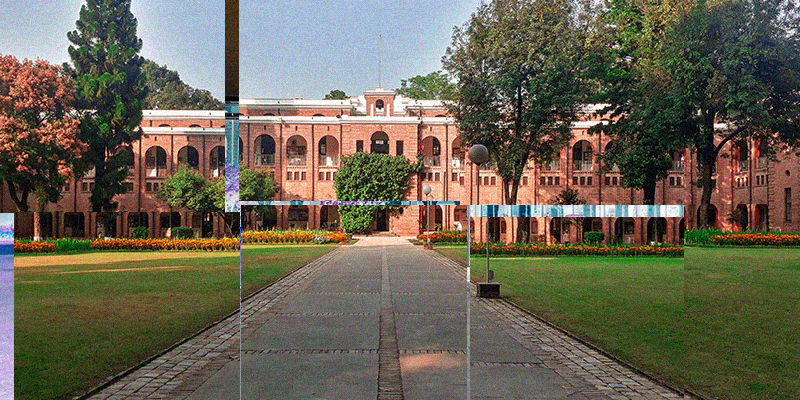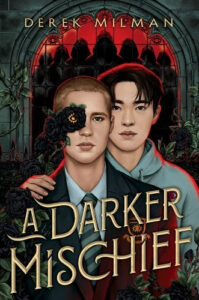It all began with a black binder.
When I first started writing A Darker Mischief, I’d never heard of Dark Academia. It wasn’t a trending aesthetic yet, or notable sub-genre, even if the many books that seemed to define it had come out years (or decades) before, like its unofficial blueprint, The Secret History by Donna Tartt, published in 1992.
The genre focuses on the rot growing within a storied institution. Characters long for and weaponize knowledge, their privilege stretching and snapping; dire acts occur in shadowy wood paneled hallways, under Victorian stone archways, and in ornate libraries. But what the genre really speaks to, is modern-day disillusionment.
Some have attributed the popularity of Dark Academia to the increasing corporatization of higher learning and budget cutbacks, but it seems obvious, since the aesthetic fully took hold during the COVID-19 pandemic, on Tumblr, that young people officially made it a thing by having their college years reduced to zoom screens and fantasizing about what a real academic experience would be.
Back to the black binder.
Back in 2017, as I was in creative stagnation, searching for my next book idea, a friend of mine who’d attended Yale, handed me a binder filled with materials detailing a year in his life as a member of a secret society. “There’s a book in this,” he told me. And he was right.
He gave me the binder as a gift. He’d read a lot of my early, unpublished work and was a champion. But he also gave it to me because I’d attended Yale as well. Laughing, I reminded him I’d been in the drama school. He said I should own my alumni standing, and in his winking cadence, there was an undertone of brotherhood, the type of blood bonds that form in centuries-old secret societies.
There are many secret societies at Yale (other schools have banned them) but the ones everyone’s heard of are The Big Three: Skull and Bones, Scroll and Key, and Wolf’s Head. Secrecy is at their core. These well-funded societies all have what’s known as tombs—large windowless buildings that serve as their HQ and generate reams of conspiracy theories about their activities and their global influence. Tomb architecture is classical, ornamented, and jaw-dropping; modern photos of their interiors are basically non-existent.
The particular secret society detailed in that binder (who informally refer to themselves as “Society”) is tomb-less—a more loose, untethered, free-wheeling group. Their goals are the exploration of Yale’s 322-year-old campus. They aim to unearth secrets and lore through what they term “explos”— highly researched, well-presented exploration reports. Their only rules: no vandalism, no stealing. The pages inside the binder contained maps, catechisms, rituals, historical documents, invitations to bacchanalian galas, coded emails, descriptions of dramatic ceremonies and esoteric traditions.
Society compiled encrypted databases of their findings, with red flags indicating places yet to be explored, with several considered The Holy Grail. Yale is the perfect place for such a society to flourish. The university is hundreds of years old, has a complex history, and hosts a treasure trove of forbidden locations and lost antiquities.
Society members have documented hidden sub-roofs, forgotten Germanic libraries, an underground river, a jazz-age water fountain made out of solid gold in the basement of a resident hall, and a maze of dangerous steam tunnels, just to name a few.
Members are trained in lockpicking, disabling security systems, and lying (called social engineering, in case they run into security personnel). They cherish blueprints, floor plans, and fire insurance maps. They wield ancient keys and wear crests. Members are chosen based on various skills, resembling an RPG: agility, stealth, hacking, and charisma, to name a few. Their Board of Directors flavors any current iteration of Society. An intellectual Board will put more focus on the history of the University, while a more adrenaline-fueled Board highlights ninja-style tactics to sneak in to bygone spaces covered in decades of dust. Their exploration reports are buffeted by luxe retreats to mansions and islands, and decadent feasts.
Transmuting the real secret society into a fictional one took years of work.In formulating A Darker Mischief, I was haunted by persistent thoughts of a gay teen who’d grown up in the rural South, won a scholarship, and was thrust into the glittering world of the elite. He’s severely isolated until he gets tapped by one of the oldest (and most powerful) secret societies in the nation. Transmuting the real secret society into a fictional one took years of work. Since the book is YA, instead of a college campus, this society needed space to breathe at a boarding school. Now that they were underage with curfews, the stakes would be higher.
I re-wrote their catechisms, worked with a Latin scholar to update their correspondence stylizations, and heavily adjusted their activities and strange rituals to fit the world of the book. I haunted websites of all the schools in the Eight Schools Association and memorized campus maps and school calendars.
What ultimately resulted was a literary melt: a merging of the fantastically real and the grittily imagined. The book is a tangled gay love story involving two boys rushing the secret society, but it is also a thriller involving a high-profile kidnapping, and a dark peek into the strings pulled by the American elite. Smashed hopes, and a sickening disillusionment in the face of corruption (Dark Academia’s signature tenets), were built into the text from the get-go. And the story begins in a library that no one knows exists.
Dark Academia may have been flourishing around me the whole time, but in this case, I like to say the genre chose me. Without realizing it, I’d created a fertile world, in the form of a Connecticut boarding school named Essex, awash with dark secrets, for the genre to bloom in, and for its sinister machinations to ooze through.
***


















